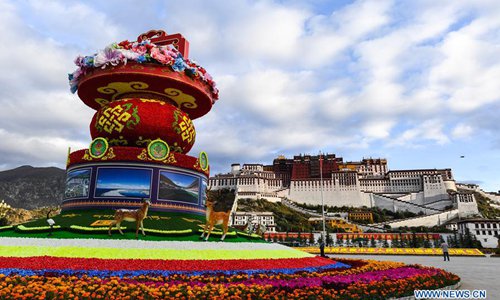
Flower decorations are set to greet the National Day in front of the Potala Palace in Lhasa, capital of southwest China's Tibet Autonomous Region, Sept. 30, 2017. China's National Day falls on Oct. 1. (Xinhua/Purbu Zhaxi)
Infrastructure funds fuel Tibet economic, social development
Southwest China's Tibet Autonomous Region has seen great development and stability in the past five years and is expected to progress even further thanks to its development path with Chinese characteristics, experts said.
"The achievement of Tibet in the past five years should give credit to the accurate plan and policies of the Communist Party of China (CPC) Central Committee," Penpa Lhamo, deputy head of the contemporary studies institute of the Tibet Academy of Social Sciences, told the Global Times on Tuesday. [Special coverage]
She noted that "the social management in Tibet has improved a lot since the 18th National Congress in 2012 with the policy of governing the region by law."
"With concern from the CPC Central Committee, aid from other provincial regions and State-owned companies and the efforts of the local government and people, Tibet has found its own development road with Chinese characteristics," said Lian Xiangmin, an expert at the China Tibetology Research Center.
Since the 18th National Congress of the CPC, Tibet has progressed greatly in constructing infrastructure including roads, power, water and communications that all brought energy to the economic and social development of the region, the Xinhua News Agency reported in September.
A total of 739 kilometers highways have been built or are under construction in the region. A new large hydropower station and airports have been constructed in the past five years, according to tibet.cn.
The per capita disposable income of rural residents in Tibet reached 9,316 yuan ($1,416) in 2016, a 13 percent increase compared with the same period in 2015, according to data released by the autonomous government in February.
During the 12th Five-Year Plan (2011-15), 2.6 billion yuan was invested in public cultural projects in Tibet. The region has been actively working on international communication to present the image of a "socialist new Tibet" to the world. This has created a stable international environment for the reform and development of Tibet.
"The upcoming 19th National Congress will put forward a clear direction for China's development as well as provide a great environment for Tibet to develop," Lian said, noting that in the future the region should continue to focus on preserving its fragile ecology during development and infrastructure construction.
Harmonious and stable
In the past five years, Tibet has also maintained a harmonious and stable condition in terms of religious and ethnic issues.
The autonomous Communist Party commission has improved the management of 1,787 temples in Tibet since 2012, promoting and leading religious groups to love the country and Buddhism, the Tibet Daily reported on Tuesday.
An annual fund of 26 million yuan is provided to lamas and nuns in Tibet for social insurance.
"Both residents and tourists feel very safe in Tibet," Lhamo said, adding that police stations in Tibet have maintained social stability and provided public services.
Chinese President Xi Jinping said in a conference in August 2015 on Tibet work that the country should "firmly take the initiative" in the fight against separatism, vowing to crack down on all activities seeking to separate the country.
"Confronting splittism will still be the challenge for Tibet in the future. This calls for enforcing ethnic cohesion under the leadership of the central government. All levels of governments in Tibet should work practically," Lian said.


















































